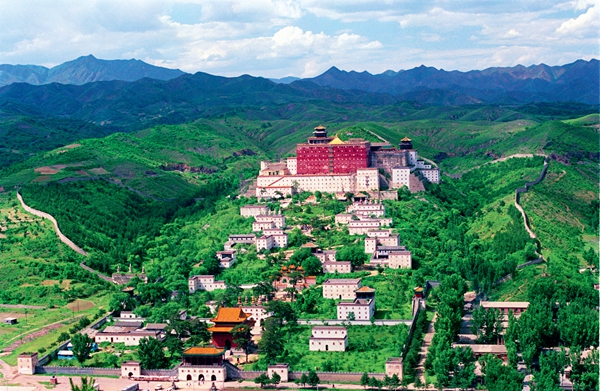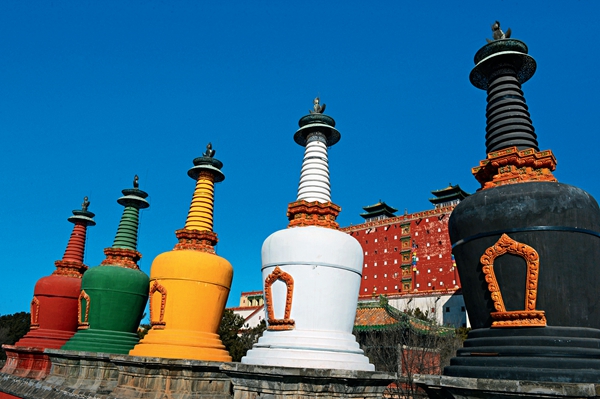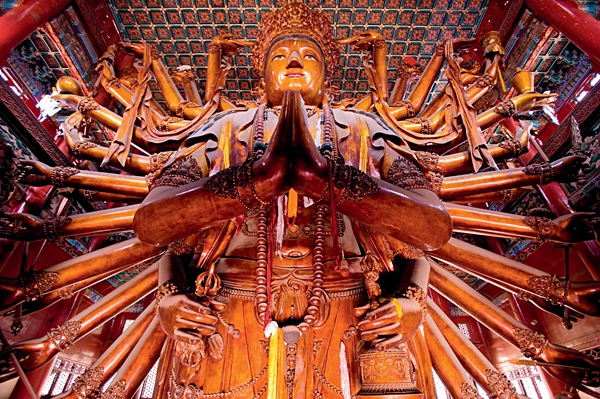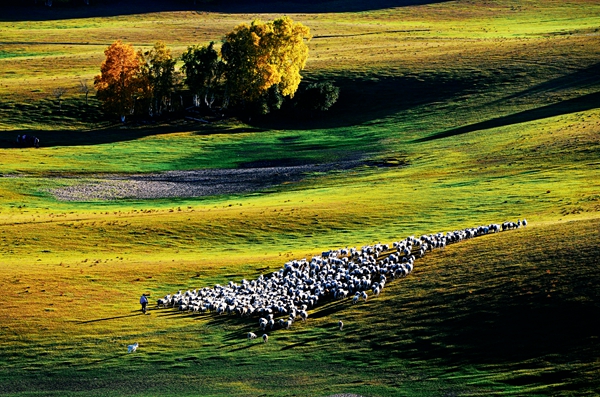Imperial Summer Resort
CHENGDE in Hebei Province is blessed with rich natural resources, a thriving eco-environment, and high forest coverage, hence its epithet “the lungs of North China.”
The city is about 230 kilometers northeast of Beijing and faces Tianjin to the south. Both rely on it as a major water source. Qinghuangdao City lies to its east and Zhangjiakou City westward. Chengde thus forms a strategic link from Beijing, Tianjin and Hebei to Inner Mongolia and Liaoning. The Chengde Mountain Resort and Bashang Grasslands are popular destinations for summer outings. In 1994, the Mountain Resort and its outlying temples were added to the UNESCO list of World Heritage Sites.
Classical Imperial Gardens
Chengde has a long history. The Longshan, or Black Pottery Culture, archeological site verifies that there was human activity here way back in the transitional period between the New Stone Age and Bronze Age. Throughout history, the central government of different periods set up administrative departments in Chengde. The economy and culture of different ethnic groups, including the Han, Xiongnu (Huns), Xianbei and Khitan peoples, and Mongols, all flourished in this region.

In the 17th century, the Qing Dynasty (1644-1911) established the Mulan Hunting Ground, around 350 kilometers northeast of Beijing. Its purpose was to train the army and strengthen frontier defense. Every autumn, the emperor led his princes, ministers, and soldiers that numbered tens of thousands on hunting excursions to Mulan Hunting Ground. Chengde Mountain Resort was built at a location midway between the capital and Mulan Hunting Ground as a place to stop and rest for a day or two on the journey.
Construction of the resort began in 1703, and took a total of 89 years, spanning the reigns of Emperor Kangxi (1654-1722), Emperor Yongzheng (1678-1735), and Emperor Qianlong (1711-1799). The plateau is in a cold temperate zone and has a continental monsoon climate, which makes it cool in summer. The Mountain Resort was a seasonal residence for the emperors succeeding Kangxi as it provided an escape from the summer heat in Beijing. It was there that China’s rulers would deal with state affairs and receive foreign envoys and leaders of ethnic minorities. Chengde was thus a political center of significance second only to Beijing.
As the emperor went to Chengde every summer, leaders of ethnic groups and court ministers alike jostled to construct their own residences there. Consequently the city’s population rapidly expanded and its economy thrived. The city bustled with carriages and people on foot going about their business, and its streets were lined with restaurants and teahouses. Chengde was, and indeed is, a going concern.

Located in the northern part of Chengde, the Mountain Resort is the largest existing complex of imperial palaces and gardens in China. It fits in perfectly with the surrounding natural landscape. The resort is divided into four parts, namely, the palace, lake, plains, and mountainous zones. The mountains are in the northwest and the water scenery in the southeast, so forming a miniature of China’s natural landscape. The complex represents a masterpiece of Chinese classical garden art.
Both Emperor Kangxi and Emperor Qianlong spent about half the year at the Mountain Resort. There they dealt with important political, military and foreign affairs, and handled relations with ethnic groups. Emperor Qianlong received the Sixth Panchen Lama, the then political and religious leader of Tibet, here, and also the first diplomatic mission from the U.K.
Emperor Jiaqing (1760-1820) and Emperor Xianfeng (1831-1861) both died here of illness, and it was also site of the famous Xinyou Coup (1861), which changed the course of Chinese history. It was then that Empress Dowager Cixi, one of the few women in Chinese history to wield power, took the helm of the state power and became the true ruler of the late Qing Dynasty.
The Eight Outer Temples
This name is misleading. During the Qing Dynasty, Chengde was located on the border with lands inhabited by ethnic groups such as the Manchu and Mongols. To unite them and facilitate their leaders’ visits to the emperor, the Qing government constructed 12 temples around the Mountain Resort, modeled on the Lama temples in Tibet and Mongolia. Because eight of these were directly under the administration of the Qing government, and located outside the city of Beijing, they became known as the Eight Outer Temples. Today, all outlying temples around the Mountain Resort are jointly referred to as the Eight Outer Temples.
At the start of the Qing Dynasty, Tibetan Buddhism (also known as Lamaism) was prevalent in Mongolian and Tibetan regions (including Qinghai and parts of Xinjiang). Its many devout followers adopted Tibetan Buddhist doctrines as their spiritual pillar. Lama dignitaries were also political leaders of considerable wealth, and administrators of temples and seminaries. The Qing government adopted a conciliatory policy with the aim of enhancing management of the frontier area and safeguarding national unity. Respect for religious beliefs and local customs was integral to this policy and to consolidating relations between the central and local governments.

In 1713, Mongolian dignitaries proposed building a temple outside the Mountain Resort as a venue for the grand celebration of Emperor Kangxi’s 60th birthday. The emperor readily agreed. The Puren Temple (Temple of Universal Benevolence) and Pushan Temple (Temple of Universal Goodness) thus became the earliest to be built outside the Mountain Resort.
In the 10 or more years that followed, groups of Tibetan and Mongolian leaders and various foreign envoys paid visits to the Qing emperor to show their respect and participate in various ceremonies. The Qing government accordingly built 10 large temples in succession in Chengde, where dignitaries could participate in religious activities. These temples surround the Mountain Resort like stars twinkling around a full moon, an image wherein the Mountain Resort is symbolic of imperial power, the temples of the country’s different ethnic groups, and which as a whole signifies national unity and ethnic solidarity.
The temples are specifically Tibetan and Han in style, and some combine the two. Their construction features refined techniques which create an impression of imperial grandeur. They are regarded as models that combine the essence of Han, Tibetan and Mongolian architecture and culture.
Mulan Hunting Ground
Situated in Weichang Manchu and Mongolian Autonomous County in Chengde, Mulan Hunting Ground was where Qing Dynasty emperors led hunting parties. It is about 135 kilometers from downtown Chengde.
Mulan Hunting Ground features fertile grasslands and many wildlife species. In 1681, Emperor Kangxi developed and designated this 14,000 sq km area as the imperial hunting ground, the largest in Chinese history. It also doubled as a place for military training exercises. In the first half of the Qing Dynasty, each autumn the emperor would lead princes, ministers and elite forces on hunting expeditions. Over the 140 years from the rule of Kangxi to that of Jiaqing, Qing emperors went on as many as 105 hunts there.

Emperor Kangxi enclosed this piece of land for political reasons. Mulan is located between Beijing and Mongolia. It therefore occupies an important strategic position. The hunts the Qing emperors organized every year were actually a pretext for military maneuvers. Their aim was to deflect and discourage attacks from Mongols and invasions by Tsarist Russia, and meanwhile, to enhance ethnic unity and frontier defense at the northern border. Mulan Hunting Ground thus acted as the Qing government’s launch pad for political and military activities.
In the Museum of Chengde Mountain Resort hangs a painting titled Emperor Qianlong Hunting in Mulan in Autumn which vividly depicts a grand hunting scenario. After the hunt a grand banquet would be held. The emperor would invite his ministers and Mongolian aristocrats to drink and enjoy song and dance performances, and present rewards for outstanding military exploits.
The common people were forbidden entry to Mulan, either to hunt or fell trees, until 1826. It was then opened to all, and people reclaimed the land. That year marked the beginning of the decline of this once grand imperial hunting ground.
Today the largest artificial forest farm in China stands on what was Mulan Hunting Ground. It is now designated a national scenic spot. Located at an altitude of over 1,000 meters, Mulan is composed of the Saihanba National Forest Park, Yudaokou Grassland and Forest Scenic Zone, and the Hongsongwa Natural Conservation Area. Besides marveling at the rolling hills and lush grassland that stretch to the horizon, visitors can also take part in hunting activities, try local dishes, and enjoy folk activities.
(Compiled by China Today)
